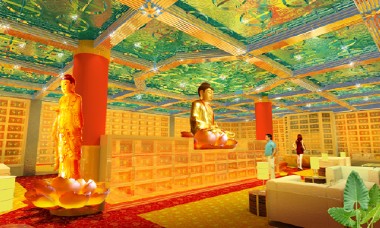From the outside, it looks like a downed spacecraft and a Las Vegas casino on the inside. There are red-carpeted VIP rooms, curved hallways lined with lavender and neon-yellow psychedelic swirls, and several statues of Buddha.
There are skylights, a café and 40,000 niches. What is it? Nirvana, a “six-star” columbarium currently being constructed in Singapore.
The massive structure will be a luxurious home for the dead in a city-state increasingly short on space. Costs will range from $2,988 for a single-urn lot to as much as $26,888 for a double-urn compartment. “Hallways with sumptuous embellishment and dignity closures remind the visitors of a 5-star hotel, so they can abandon the fear and sadness but instead cherish the memories and remembrance,” reads the Nirvana website.
Singapore is the smallest nation in Southeast Asia, with a land area less than most U.S. counties. The population is 5 million, which is expected to rise by 40 percent over the next half-century.
“It’s a spatial competition between the living and the dead,” Lily Kong, a National University of Singapore researcher, recently told the New York Times.
A national law states that bodies must be exhumed after 15 years to make room for new burials. This has led to an entirely new vocation across the country: the grave digger-upper.
Singapore is not the only Asian nation building fancy modern facilities to store their dead. At the Nichiryoku Company’s seven-story mechanized columbarium in Yokohama, a port city near Tokyo, family members swipe smart cards in order to view the cremated remains of their loved ones. Within 60 seconds, the appropriate urn is transferred mechanically from an underground vault with nearly 9,000 tomb spaces to one of 10 viewing areas, which are decorated with cherry blossoms, snowdrops and roses. The facility is open 24 hours a day. Once the only one of its kind, Nichiryoku now operates three other columbarium in Japan.
Hong Kong city officials recently made a visit to Yokohama, seeking solutions on how to manage their own dead problems. The mega city, squeezed between the South China Sea and steep tropical peaks, has 7 million residents and strict zoning laws. Waiting lists at local burial sites run as long as four and half years and spots in some graveyards go for $35,000.
Current plans involve converting abandoned industrial buildings to modern columbarium like the one in Yokohama. Some local officials have encouraged the increased use of alternate burial methods, such as scattering ashes at sea.
A paper published by Kin Wai Michael Siu in the Spring 2005 issue of the MIT publication, Design Issues notes that the Cantonese tradition insists that for a spirit to live forever a body must be placed underground. Thus, scattering ashes at sea, or even placing them in a columbarium is sacrilegious, argues Siu. His paper proposes a solution that would solve the space crunch and adhere to the custom of underground burial, the invisible niche: “This involves putting the ashes of the deceased after cremation into degradable urns to be buried underground. The ashes will enrich the environment. After the ashes have completely decomposed, the land will be ready for more ashes.”
Back in Singapore, the grave digger-uppers make way for the next generation of corpses. The Times article poignantly describes the work of one, a Mr. Alex Wong Shun Feng, of the Choa Chu Kang Cemetery:
“His thick, callused fingers pluck the bones from the earth with delicate precision and his cigarette sends a swirl of smoke into the air like a column of votive incense. When his red plastic tub is filled, Mr. Wong carries it to the head of the grave, where it becomes a true washtub as he ritually cleanses the bones with a bottle of rice wine. He shakes the bones into large white plastic bags and family members carry them away to a nearby crematory, shielded from the sun by small paper umbrellas and trailed, Mr. Wong said, by the spirits of the deceased.”










